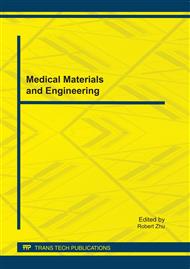[1]
F. Nicoud,T. Schonfeld, Integral boundary conditions for unsteady biomedical CFD applications , J. Numer. Meth. Fluids , 40(2002)457–465.
DOI: 10.1002/fld.299
Google Scholar
[2]
Beverly T.Tang,Christopher P.Chen,Mary T.Draner,Abdominal aortic hemodynamics in young healthy adults at rest and during lower limb exercise:quantification using image-based computer modeling, J.Am J Physiol Heart Circ Physiol, 291(2006)668-676.
DOI: 10.1152/ajpheart.01301.2005
Google Scholar
[3]
Andrea S. Les, Shawn C. Shadden, C.Alberto Figueroa, Quantification of Hemodynamics in Abdominal Aortic Aneurysms During Rest and Exercise Using Magnetic Resonance Imaging and Computational Fluid Dynamics ,J. Annals of Biomedical Engineering, 38(2010)1288–1313.
DOI: 10.1007/s10439-010-9949-x
Google Scholar
[4]
Thomas Frauenfelder, Mourad Lotfey, Thomas Boehm, Computational fluid dynamics: hemodynamic changes in abdominal aortic aneurysm after stent-graft implantation,J. Cardio vascular and Interventional Radiology, 29(2006)613-623.
DOI: 10.1007/s00270-005-0227-5
Google Scholar
[5]
YANG Jin-you, YU Hang, LIU Jing,Compared thoracic aortic dissection with normal aortic blood flow dynamics based on CT images,J.Biomedical Engineering and Clinical Medicine, 14(2010)390-393.
Google Scholar
[6]
Shahcheraghi N, Dwyer HA, Cheer AY, Unsteady and three-dimensitional simulation of blood flow in the human aortic arch,J.Journal of Biomechanical Engineering, 124(2002)378-387.
DOI: 10.1115/1.1487357
Google Scholar
[7]
BarbaraM.Johnston,Peter R.Johnston,Stuart Corney,David Kilpatrick, Non-Newtonian blood flow in human right coronary arteries Transient simulations , J.Journal of Biomechanics, 39( 2006)1116–1128.
DOI: 10.1016/j.jbiomech.2005.01.034
Google Scholar
[8]
JonghwunJung,Robert W.Lyczkowski,Chandrakant B.Panchal, Multiphase hemodynamic simulation of pulsatile flow in a coronary artery,J.Journal of biomechanics, 39(2006)2061-2073.
DOI: 10.1016/j.jbiomech.2005.06.023
Google Scholar
[9]
A.K. Nieman,J.Udesen,S.Thrysoe, Can sites prone to flow induced vascular complications in a-vfistulas beassessed using computational fluid dynamics?,J.Journal of Biomechanics, 43(2010)2002-2009.
DOI: 10.1016/j.jbiomech.2010.02.037
Google Scholar
[10]
Christopher P.Cheng, David Parker, Charles A Taylor,Quantification of Wall Shear Stress in Large Blood Vessels Using Lagrangian Interpolation Functions with Cine Phase-Contrast Magnetic Resonance Imaging,J. Annals of Biomedical Engineering, 30(2002)1020–1032.
DOI: 10.1114/1.1511239
Google Scholar
[11]
Christopher P.Cheng,Robert J.Herfkens,Charles A.Taylor,Abdomianl arotci hemodynamic conditions in healthy subjects aged 50-70 at rest and during lower limb exercise:in vivo quantification using MRI,J.Atherosclerosis, 138(2003)323-331.
DOI: 10.1016/s0021-9150(03)00099-6
Google Scholar


